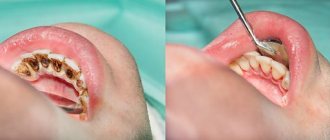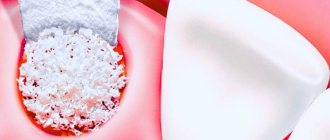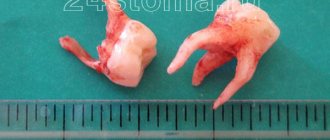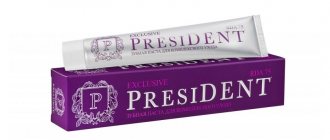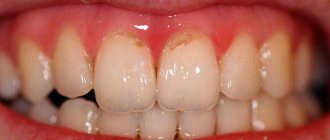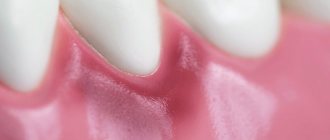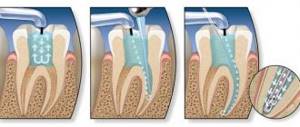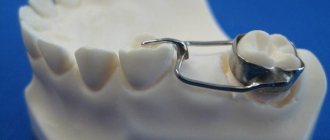Stone removal with 20% discount
Moscow
Mineralized deposits on teeth are a good enough reason to visit a dentist. Timely removal of tartar will subsequently avoid such unpleasant manifestations as caries, gingivitis, and periodontitis.
Initially, plaque does not cause any discomfort, but gradually the smile takes on an unaesthetic appearance, bad breath appears, and the surface of the teeth becomes rough to the touch with the tongue. You can get rid of the stone only by visiting the dentist.
According to patient reviews, after the procedure there is an immediate feeling of cleanliness and freshness in the mouth. Well, when we smile in the mirror, we immediately see the result - clean, beautiful teeth without plaque.
What is tartar
Tartar is hardened plaque on teeth, usually brown in color. The resulting deposits on the teeth gradually harden and are firmly held on the enamel. The stone contains compounds of calcium, iron and phosphorus, which explains its special strength and the impossibility of removal at home.
How is tartar formed?
Within two hours after brushing your teeth, plaque begins to accumulate on them, formed as a result of the interaction of bacteria, saliva and microscopic food debris. Due to the calcium compounds contained in saliva, mineral residues accumulate, soft deposits harden and settle firmly on the teeth.
The finely porous surface of the enamel is also one of the factors that provoke the formation of stone. Moreover, the greater the porosity, the higher the likelihood of plaque formation.
Causes
Tartar can form not only in adults, but even in teenagers. In any case, it must be removed regularly, especially if there is a hereditary predisposition to increased stone formation.
Among the main causes of tartar formation are:
- insufficient oral hygiene – irregular and improper brushing of teeth, use of a toothbrush of insufficient rigidity;
- metabolic disorders - especially salt metabolism, due to which accelerated mineralization of plaque is observed;
- improperly distributed chewing process - in this case, chewing food occurs mainly on the right or left side;
- drinking strong tea and coffee in large quantities.
A particularly unpleasant picture is observed on the teeth of smokers. In this case, nicotine resins enter into the process of stone formation, due to which the teeth acquire a dark brown, unkempt color.
How and why hard plaque forms on teeth
The oral mucosa is simply teeming with all kinds of bacteria, the quantities of which are in a certain ratio to each other. When the bacterial balance is disturbed, some microbes can multiply excessively and provoke all kinds of dental ailments. If for some reason teeth brushing has become poor and irregular, then a concentrate of 200 billion different bacteria will immediately react to this by the appearance of a mineralized film. It actively forms within 15 hours, and within a week it becomes quite noticeable plaque, which will turn into hard tartar in six months.
How to remove tartar in dentistry
Tartar is removed in a dental clinic using modern techniques that allow the stone to be completely destroyed. The earlier deposits are detected, the easier it is to remove them.
The procedure takes about an hour in total. First, the doctor removes the supragingival stone, and, if necessary, the subgingival stone. Then the teeth are polished and a fluoride toothpaste is applied.
In their work, dentists usually combine several methods of stone removal. This approach allows you to get the most effective results. Once the problem is eliminated, the risk of complications is significantly reduced.
Ultrasonic teeth cleaning is the best modern solution
The ultrasonic method of removing tartar combines high productivity and special advantages, such as:
- No aggressive or harmful chemical effects on enamel;
- Minimal trauma, can be used even with fragile tooth enamel;
- The ability to effectively act on deposits of any nature, removing plaque even in hard-to-reach places;
- The presence of an antiseptic effect (elimination of harmful microorganisms);
- Efficiency and painlessness of the procedure;
- Affordable price.
Methods for removing tartar in dentistry
Tartar is cleaned exclusively using special equipment that allows you to quickly destroy the structure of mineralized deposits. The choice of methods depends on your financial capabilities, as well as your health status. Naturally, the doctor has the right to recommend to you the method that will be most effective in your case.
The dentist recommends professional teeth cleaning regularly, approximately once every six months. By following the recommendations of doctors, you will always be confident in the health of your teeth. And in your beautiful smile too.
Today, dentists use several techniques - ultrasound, chemical, laser, mechanical and Air-Flow.
Ultrasonic cleaning
One of the easiest and most effective ways to brush your teeth. Under the influence of ultrasonic waves, even the largest, most durable and oldest deposits are destroyed. The main advantage of the method is the preservation of tooth enamel and the ability to treat subgingival pockets. Under the influence of ultra-high frequency waves, pathogenic bacteria also die, which contributes to the most complete disinfection of the oral cavity.
Cleaning is carried out using a special attachment - a scaler, which makes it possible to remove deposits even in the most difficult to reach places. During the manipulation, teeth are simultaneously polished, which also reduces the risk of rapid formation of new plaque.
Before the procedure, a gel is applied to the teeth, which, under the action of the device, releases free oxygen, which is involved in the process of destruction of the stone. Ultrasonic cleaning allows you to thoroughly clean not only the surface of the teeth and the interdental space, but also the periodontal canals, which is especially important for those who are prone to or suffer from periodontitis.
Despite the safety of the method, there are contraindications - the first trimester of pregnancy, the presence of implants and orthopedic structures, ARVI, arrhythmia, asthma, chronic bronchitis, tooth sensitivity. It is also undesirable to carry out the procedure on children and adolescents during the period of change in bite.
Important. When removing tartar with a scaler, the patient may feel pain, especially if the enamel is thinned. In such cases, the doctor applies a special anesthetic gel to the teeth.
The session lasts about an hour, after which the doctor polishes the teeth and applies fluoridated gel.
Chemical
It is carried out using special gels or pastes containing components that actively affect tartar and destroy its structure as a result of a chemical reaction. The acids and alkalis included in the preparations soften the stone, after which it is quite easy to remove.
The procedure is absolutely painless and, in some ways, even comfortable. The products have a pleasant taste and do not irritate the mucous membranes. Before the procedure, the doctor protects the patient’s gums and lips from exposure to chemicals. After removing the composition, the doctor polishes the surface of the teeth with an electric brush with a special paste.
The main advantage of the method is teeth cleaning while simultaneously whitening them. The enamel not only acquires its natural color, but becomes several shades lighter.
Among the disadvantages, it should be noted the possibility of damage (thinning) of the enamel and the inability to fully clean the teeth, since the compositions do not penetrate into hard-to-reach places. Chemical teeth cleaning is recommended only for removing hard tartar. If you treat soft plaque with compounds, it is very easy to damage the enamel (it becomes brittle and loose).
The method is considered one of the most inexpensive, but recently it has become less and less popular precisely because of the possibility of damage to the enamel.
Laser cleaning
Compared to the ultrasonic procedure, laser cleaning is considered more gentle, but no less effective. The destruction of the stone occurs due to the action of long waves, without direct contact of the device with the teeth. The method is painless, no anesthesia is required. Healthy tissues and enamel are not damaged.
The laser “removes” stone and any formations from the surface of the teeth layer by layer, while also having a wound-healing and bactericidal effect on the oral cavity. The use of laser stimulates tissue regeneration. In this case, we are talking about increasing the permeability of enamel for calcium and fluoride ions, which helps strengthen teeth.
The disadvantages of the method include the impossibility of laser cleaning of subgingival pockets and the high cost of the procedure.
Contraindications – pregnancy, the presence of endoprostheses in the body, viral and infectious diseases, braces.
Laser cleaning lightens the enamel. Bleaching is a separate procedure, which requires mandatory removal of stones.
Mechanical
Nowadays the method is used extremely rarely, but at one time it was the only way to remove stones. The doctor uses a special bur to pry up the stone, separate it from the tooth and then clean the surface.
Mechanical cleaning removes only surface deposits that can be removed with a boron. Patients in most cases experience discomfort and pain. The only advantage of the method is the low cost of the procedure.
Air-Flow
An effective way to remove hard and soft dental plaque. An abrasive mixture consisting of soda, water and flavoring is applied under pressure to the surface of the tooth, easily and quickly removing plaque and stones. Professional cleaning using the Air-Flow method (translated as air flow) does not injure the gums and does not damage the enamel.
During and after the procedure, patients do not experience pain or discomfort. Cleaning using the Air-Flow method allows you to quickly and carefully remove dental plaque, clean subgingival pockets and remove pathological granulations.
After the procedure, the teeth acquire a natural shade, but are not whitened.
Read more about the possibilities of ultrasonic cleaning
Let's continue the conversation about ultrasonic teeth cleaning - the most effective modern method of removing dental plaque, almost completely safe and capable of cleaning teeth from:
- plaque, including pigmentation;
- stone at the base of the tooth, above and below the gum.
The procedure is performed using an ultrasonic scaler, through which water is supplied through a vibrating metal nozzle: high-frequency vibration destroys deposits on both sides of the tooth, and the water flow washes out these particles. There simply cannot be any hard-to-reach places for an ultrasound scaler.
The effect is complemented by an antibacterial effect. The procedure is indicated for use with a regularity of once a year.
A competent dentist will definitely prescribe teeth cleaning before treatment; before dental operations, the procedure is absolutely necessary.
This treatment will reliably protect against infection by removing bacteria and germs from the oral cavity. Ultrasound cleaning will also help when choosing the color of fillings and implants.
The importance of the procedure during implantation is determined by the following points:
- deep cleaning of periodontal pockets, including hard-to-reach ones;
- disinfection of dental sinuses and canals;
- teeth whitening on both sides;
- prevention of caries and gingivitis.
Subsequent processing: fluoridation + polishing
A mandatory step after brushing (except for Air-Flow) is teeth polishing. After the procedure, the enamel becomes slightly rough, as microscopic particles of stone and mechanical irregularities remain on it. If the surface of the teeth is not polished, plaque will settle much more intensely than before brushing.
For polishing, use special brushes or a water-air jet with an abrasive mixture.
To reduce tooth sensitivity after the procedure and strengthen the enamel, special compounds with a high content of sodium fluoride are applied to the surface of the teeth. The procedure is not mandatory, but its implementation will help to quickly restore damaged layers.
Stone removal with 20% discount
Moscow
Removal at home
It is impossible to remove hardened tartar at home. The only thing you can do is try to remove soft dental plaque. To do this, use special rotating toothbrushes and abrasive toothpastes. You can use such compositions no more than twice a week so as not to damage the enamel.
The use of folk remedies gives a dubious effect, but, if desired, you can try and see for yourself.
- Radish and lemon juice. Grate the radish, add natural lemon juice. Wet the brush and rub your teeth. (The main component of this “elixir” is acids that destroy enamel).
- Eggplant ash. The vegetable should be burned over an open fire, and the most problematic areas should be rubbed with ashes every day. The expected result can be observed after a week and a half.
- Horsetail decoction (for 200 grams of water - 30 grams of dry herb). Boil for half an hour. Rinse your mouth morning and evening with 1/3 cup.
Important. Among the “folk” recipes found online, there is an infusion of celandine, the use of which poses a health hazard.
Is it painful to remove tartar?
The answer to this question is not clear-cut.
Mechanical cleaning causes some discomfort and minor pain in patients.
Laser, chemical and Air-Flow cleaning are absolutely painless; anesthesia is not required.
Ultrasonic treatment of teeth with a scaler in most cases requires the application of a local anesthetic, especially in cases of increased tooth sensitivity.
Modern dentistry has an extensive list of painkillers. If, because of your imaginary fear, you allow the formation of old formations on your teeth, you will subsequently have to undergo long and expensive treatment.
